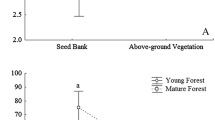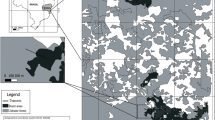Abstract
Vegetation composition differs significantly between ancientand recent forest, due to slow colonization capacity of typical forest speciesand the higher abundance of early successional species in recent forest.However, little is known about differences in persistent seed bank compositionbetween ancient and recent forest and about the interaction between seed bankand vegetation in relation with forest age. We surveyed the seed bank and theunderstorey vegetationcomposition in transects from ancient to recent forest. Seed bank and fieldlayer vegetation characteristics and similarity between seed bank andvegetationwere analysed in relation to recent forest age and distance to the ancientforest. A total of 39 species and 14,911 seedlings germinated, whichcorresponds with a seed density of 12,426 seeds/m2.Total seed density is significantly higher in the youngest recent forest parcel(55 years). Also the seed bank composition in the youngest forest parceldifferssignificantly from the other parcels. After a longer period of reforestation,the seed bank approaches that of the ancient forest, suggesting seed bankdepletion, although the seed bank is permanently replenished to some extent byseed bank forming species from local disturbances. Seed bank composition doesnot change significantly with distance to the ancient forest. Similaritybetween seed bank and vegetation composition, nomatter the forest age, is very low, but decreases with increasing forest age.The most frequent species in the vegetation are absent in the seed bank andvice versa. The contribution of forest species is highin the vegetation and they almost not occur in the seed bank, while species offorest edges and clearings, and species of disturbed environments are morefrequent in the seed bank. The seed bank is mainly composed of earlysuccessional species of former forest stages or species which temporary occurinsmall-scale disturbances. The seed bank may enhance the negative effects ofearlysuccessional, mainly competitive species to the forest species richness in therecent forest. In this respect, forest management should minimise forestdisturbances, to prevent germination of competitive species form buriedseeds.
Similar content being viewed by others
References
Beatty S.W. 1991. Colonization dynamics in a mosaic landscape: the buried seed pool. Journal of Biogeography 18: 553–563.
Bekker R.M., Verweij G.L., Smith R.E.N., Reine R., Bakker J.P. and Schneider S. 1997. Soil seed banks in European grasslands: does land use affect regeneration perspectives? Journal of Applied Ecology 34: 1293–1310.
Bossuyt B., Hermy M. and Deckers J. 1999a. Migration of herbaceous plant species across ancient-recent forest ecotones in central Belgium. Journal of Ecology 87: 628–638.
Bossuyt B., Deckers J. and Hermy M. 1999b. A field methodology for assessing man-made disturbance in forest soils developed in loess. Soil Use and Management 15: 14–20.
Bossuyt B. and Hermy M. 2000. Ecological restoration of the understorey layer: evidence from ancient-recent forest ecotones. Applied Vegetation Science 3: 43–50.
Bossuyt B. and Hermy M. 2001. Influence of land use history on seed banks in European temperate forest ecosystems: a review. Ecography 24: 225–238.
Bossuyt B., Heyn M. and Hermy M. 2000. Concentrating seed bank samples results in a three times larger estimation of a forest seed bank. Functional Ecology 14: 766–768.
Brown A.H.F. and Oosterhuis L. 1981. The role of buried seed in coppicewoods. Biological Conservation 21: 19–38.
Brunet J. and von Oheimb G. 1998. Migration of vascular plants to secondary woodlands in southern Sweden. Journal of Ecology 86: 429–438.
Buckley G.P., Howell R. and Anderson M.A. 1997. Vegetation succession following ride edge management in lowland plantations and woods. II. The seed bank resource. Biological Conservation 82: 305–316.
Chambers J.C. and McMahon J.A. 1994. A day in the life of a seed: movements and fates of seeds and their implications for natural and managed systems. Annual Review of Ecology and Systematics 25: 263–292.
Cosijns E., Leten M., Hermy M. and Triest L. 1994. Statistics of the wild flora of Flanders. (in Dutch). Report under the authority of The Institute of Nature Conservation. Ministery of the Flemish Community.
Crawford R.M.M. 1989. Studies in Plant Survival. Ecological Case Histories of Plant Adaptation to Adversity. Blackwell Scientific Publications, London.
De Graaf M.C., Verbeek P.J., Bobbink R. and Roelofs J.G. 1998. Restoration of species-rich dry heaths: the importance of appropriate soil conditions. Acta Botanica Neerlandica 47: 89–111.
Dougall T.A.G. and Dodd J.C. 1997. A study of species richness and diversity in seed banks and its use for the environmental mitigation of a proposed holiday village development in a coniferized woodland in south east England. Biodiversity and Conservation 6: 1413–1428.
Eriksson O. 1995. Seedling recruitment in deciduous forest herbs: the effects of litter, soil chemistry and seed bank. Flora 190: 65–70.
ESRI 1990. PC Arc/Info 3.4.C. Environmental Systems Research Institute Inc., Redlands, CA.
Falínska K. 1999. Seed bank dynamics in abandoned meadows during a 20-year period in the Bialowieza National Park. Journal of Ecology 87: 461–475.
Granström A. 1988. Seed banks at six open and afforested heath-land sites in southern Sweden. Journal of Applied Ecology 25: 297–306.
Halpern B.C., Evans S.A. and Nielson S. 1999. Soil seed banks in young closed-canopy forets of the Olympic Peninsula, Washington: potential contributions to understory reinitiation. Canadian Journal of Botany 77: 922–935.
Hanf M.s.d. Die ackerunkraüter und ihre Keimlinge. BASF, Ludwigshafen.
Hermy M. 1994. Effects of former land use on plant species diversity and pattern in European deciduous woodlands. In: Boyle T.J.B. and Boyle C.E.B. (eds), Biodiversity, Temperate Ecosystems and Global Change. Springer-Verlag, Berlin, pp. 123–144.
Hermy M. and Stieperaere H. 1981. An indirect gradient analysis of the ecological relationships between ancient and recent riverine woodlands to the south of Bruges. Vegetatio 44: 46–49.
Hermy M., Honnay O., Firbank L., Grashof-Bokdom C. and Lawesson J.E. 1999. An ecologcial comparison between ancient and other forest plant species of Europe, and the implications for forest conservation. Biological Conservation 91: 9–22.
Hester A.J., Gimingham C.H. and Miles J. 1991. Succession from heather moorland to birch woodland. III Seed availability, germination and early growth. Journal of Ecology 79: 329–344.
Hill M.O. and Stevens P.A. 1981. The density of viable seed in soils of forest plantations in upland Britain. Journal of Ecology 69: 693–709.
Hodgson J.G., Grime J.P., Hunt R. and Thompson K. 1995. The Electronic Comparative Plant Ecology. Chapman and Hall, London.
Holderegger R. 1996. Effects of litter removal on the germination of Anemone nemorosa L. Flora 191: 175–178.
Honnay O., Degroote B. and Hermy M. 1998. Ancient-forest plant species in Western Belgium: a species list and possible ecological mechanisms. Belgian Journal of Botany 130: 139–154.
Honnay O., Hermy M. and Coppin P. 1999. Habitat quality factors affecting the colonisation of forest plant species. Forest Ecology and Management 115: 157–170.
Kalamees R. and Zobel M. 1998. Soil seed bank composition in different successional stages of a species rich wooded meadow in Laelatu, western Estonia. Acta Oecologia 19: 175–180.
Kent M. and Coker P. 1995. Vegetation Description and Analysis. John Wiley & sons, West Sussex, England.
Kjellsson G. 1992. Seed banks in Danish deciduous forests: species composition, seed influx and distribution pattern in soil. Ecography 15: 86–100.
Lambinon J., De Langhe J.E., Delvosalle L. and Duvigneaud J. 1998. Flora van België, het groothertogdom Luxemburg, Noord-Frankrijk en de aangrenzende gebieden. Nationale Plantentuin van België, Meise.
Leck M.A. and Leck C.F. 1998. A ten-year seed bank study of old field succession in central New Jersey. Bulletin of the Torrey Botanical Club 125: 11–32.
Livingston R.B. and Allessio M.L. 1968. Buried viable seed in successional field and forest stands, Harvard Forest, Massachusetts. Bulletin of the Torrey Botanical Club 95: 58–69.
Londo G. 1976. The decimal scale for relevés of permanent quadrats. Vegetation 33: 61.
Matlack G.R. 1994. Plant species migration in a mixed-history forest landscape in eastern North America. Ecology 75: 1491–1502.
McDonald A.W., Bakker J.P. and Vegelin K. 1996. Seed bank classification and its importance for the restoration of species-rich flood meadows. Journal of Vegetation Science 7: 157–164.
Milberg P. 1995. Soil seed bank after eighteen years of succession from grassland to forest. Oikos 72: 3–13.
Mitchell R.J., Marrs R.H. and Auld M.H.D. 1998. A comparative study of the seed banks of heathland and successional habitats in Dorset, Southern England. Journal of Ecology 86: 588–596.
Muller F.M. 1978. Seedlings of the North-western European Lowland. A Flora of Seedlings. Dr W. Junk B.V. Publishers, The Hague.
Noirfalise A. 1984. Forêts et stations forestières en Belgique. Presses agronomiques, Gembloux.
Oosting H.J. and Humphreys M.E. 1940. Buried viable seeds in a successional series of old field and forest soils. Bulletin of the Torrey Botanical Club 67: 253–273.
Peterken G.F. 1977. A method for assessing woodland flora for conservation using indicator species. Biological Conservation 6: 239–245.
Peterken G.F. and Game M. 1984. Historical factors affecting the number and distribution of vascular plant species in the wood-lands of central Lincolnshire. Journal of Ecology 72: 155–182.
Petrov V.V. and Palkina T.A. 1983. The content of dormant viable seeds in the soil of a broad-leaved forest and a spruce plantation. Vestnik Moskovskogo Universiteta, Biologya 38: 31–35.
Pickett S.T.A. and Mc Donnell M.J. 1989. Seed bank dynamics in temperate deciduous forest. In: Leck M.A., Parker V.T. and Simpson R.L. (eds), Ecology of Soil Seed Banks. Academic Press, Inc, London, pp. 123–145.
Rackham O. 1980. Ancient Forest, Its History, Vegetation and Uses in England. Edward Arnold, London.
Roberts H.A. and Vankat J.L. 1991. Floristics of a chronosequence corresponding to old field-deciduous forest succession in south-western Ohio. II. Seed banks. Bulletin of the Torrey Botanical Club 118: 377–384.
SPSS 1998. SPSS 8.0. SPSS Inc., Chicago.
Staaf H., Jonsson M. and Olsén L.-G. 1987. Buried germinative seeds in mature beech forests with different herbaceous vegetation and soil types. Holarctic Ecology 10: 268–277.
Tack G., Van Den Brempt P. and Hermy M. 1993. An Historical Ecology of the Forests of Flanders (in Dutch). Davidsfonds, Leuven.
ter Heerdt G.N.J. and Drost H.J. 1994. Potential for the development of marsh vegetation from the seed bank after a drawdown. Biological Conservation 67: 1–11.
ter Heerdt G.N., Verweij G.L., Bekker R.M. and Bakker J.P. 1996. An improved method for seed bank analysis: seedling emergence after removing the soil by sieving. Functional Ecology 10: 144–151.
Thompson K. and Grime J.P. 1979. Seasonal variation in the seed banks of herbaceous species in ten contrasting habitats. Journal of Ecology 67: 893–921.
Thompson K., Bakker J. and Bekker R.M. 1997. The Soil Seed Banks of North West Europe: Methodology, Density and Longevity. Cambridge University Press.
van der Valk E.G. and Pederson R.L. 1989. Seed banks and the management and restoration of natural vegetation. In: Leck M.A., Parker V.T. and Simpson R.L. (eds), Ecology of Soil Seed Banks. Academic Press, Inc., London, pp. 329–344.
Warr J.S., Kent M. and Thompson K. 1994. Seed bank composition and variability in five woodlands in south-west England. Journal of Biogeography 21: 151–168.
Willems J.H. and Bik L.P.M. 1998. Restoration of high species density in calcareous grassland: the role of seed rain and soil seed bank. Applied Vegetation Science 1: 91–100.
Wulf M. 1994. Ñberblick zur Bedeutung des Alters von Lebensge-meinschaften, dargestellt am beispiel “historischalter Wälter”. Norddeutsche Naturschutzakademie Berichte 7/3: 3–14.
Author information
Authors and Affiliations
Rights and permissions
About this article
Cite this article
Bossuyt, B., Heyn, M. & Hermy, M. Seed bank and vegetation composition of forest stands of varying age in central Belgium: consequences for regeneration of ancient forest vegetation. Plant Ecology 162, 33–48 (2002). https://doi.org/10.1023/A:1020391430072
Issue Date:
DOI: https://doi.org/10.1023/A:1020391430072




